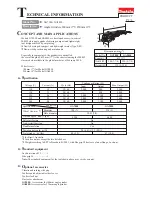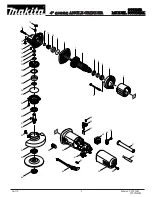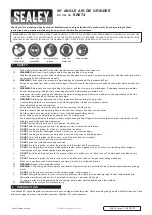
Informaciones
Generales de
Seguridad
(Continuación)
Esta herramienta está diseñada para
usarse en un circuito que tenga un
tomacorriente como el que está ilustrado
en la Figura 1. La herramienta tiene un
enchufe de conexión a tierra que es
como el enchufe ilustrado en la Figura 1.
Si no hay un tomacorriente con
conexión a tierra disponible, se puede
usar un adaptador temporal, similar al
adaptador ilustrado en la Figura 2, para
conectar este enchufe en un
tomacorriente bipolar como se muestra.
El adaptador temporal se debe usar
únicamente hasta que un electricista
calificado pueda conectar un
tomacorriente adecuado con conexión
a tierra. La lengüeta rígida de color
verde, espigo, y otros elementos que
salen del adaptador deben conectarse
a una conexión a tierra permanente,
tal como una caja de tomacorriente
conectado a tierra correctamente.
SEGURIDAD PERSONAL
No use este producto en forma
inadecuada. La exposición excesiva
a la vibración, trabajar en posiciones
incómodas y los movimientos de
trabajo repetitivos pueden causar
lesiones a las manos y brazos. Deje de
usar cualquier herramienta si aparece
incomodidad, cosquilleo o dolor
y consulte a un médico.
1. Manténgase alerta, preste atención
a lo que hace y use su sentido
común cuando maneje cualquier
herramienta a motor. No use la
herramienta si está cansado o bajo
la influencia de drogas, alcohol
o medicamentos. Un momento de
distracción mientras maneja
cualquier herramienta a motor
puede dar como resultado graves
lesiones personales.
Evite arranques accidentales.
Asegúrese de que el interruptor esté
en la posición de apagado (OFF) antes
de hacer algún ajuste, cambiar los
accesorios o guardar la herramienta.
El transportar herramientas con el dedo
en el interruptor encendido favorece
los accidentes.
2. Quite las llaves de ajuste o llaves
de tuercas antes de encender la
herramienta. Acostúmbrese a
verificar y quitar las llaves de ajustes
y llaves de tuercas de la herramienta
antes de encender. Una llave de
ajuste o llave de tuercas conectada
a una pieza giratoria de la
herramienta puede provocar
lesiones personales.
3. No intente alcanzar
lugares alejados.
Mantenga un buen
soporte y equilibrio en
todo momento. Un
soporte y equilibrio adecuados
permiten un mejor control de
la herramienta en situaciones
inesperadas.
4. Trabaje siempre en
un área bien ventilada.
Use una máscara para
polvo y gafas de seguridad
aprobadas por OSHA.
5. Mantenga las manos alejadas
de las piezas giratorias.
6. Sujete la pieza de trabajo.
Use abrazaderas o una prensa para
sujetar la pieza de trabajo, cuando
haga falta. Es mejor que usar sus
manos y le permite usar ambas manos
para trabajar la herramienta.
7. Utilice siempre ruedas del tamaño
correcto y hechas para su
rectificadora. Las ruedas que no
coincidan con la ferretería de
montaje funcionarán de forma
excéntrica, causando un gran riesgo
o lesión al usuario y daño a la
herramienta.
8. Nunca se pare sobre la
herramienta. Pueden ocurrir
lesiones graves si se vuelca la
herramienta o si toca la
herramienta sin querer.
9. No deje nunca la herramienta
encendida sin vigilancia. Apague la
unidad. No se aleje de la
herramienta hasta que no se
detenga por completo.
CUIDADO Y USO DE LA
HERRAMIENTA
No use la herramienta si el interruptor
no la enciende o no la apaga.
Cualquier herramienta que no pueda
ser controlada con el interruptor es
peligrosa y debe repararse.
1. Esta herramienta NO debe
modificarse ni usarse para ninguna
aplicación que no sea la aplicación
para la cual fue diseñada.
27 Sp
Cable de corriente
Lámpara
Interruptor de
encendido/apagado
Protecciones
para los ojos
Amortiguador
de chispas
Rueda
abrasiva
Apoyo
del
trabajo
Protección
de la rueda
Base
Interruptor de corriente
Figura 2
Características de su rectificadora
Figura 1
Figura 2
Medio de conexión a tierra
Tapa de la caja de tomacorriente
conectado a tierra
Tornillo
metálico
DG490500CK, DG490700CK
Operating Instructions
6
www.chpower.com
For Technical Assistance, call 1-800-424-8936 or visit our website:
www.chpower.com
Please provide following information:
- Model number
- Serial number (if any)
Address any correspondence to:
Campbell Hausfeld
Attn: Customer Service
100 Production Drive
Harrison, OH 45030 U.S.A.
Troubleshooting
Although your new bench grinder is
very simple to operate, if you do
experience problems, check the
following:
1.
Grinder will not start
Check that there is “mains” at the
socket; test with an electrical
appliance; check the connections in
the plug; correct and tighten poor
connections; check the fuse; if
suspect replace with correct rating.
2.
Wheel wobbles or vibrates
Check that the lock-nut is tight.
Check that the wheel is correctly
located on the shaft and locating
washer. If excessive pressure has
been used or the wheel has
“caught”, it may be damaged
causing it to vibrate. If there is any
evidence that the wheel is damaged,
do not use, remove it and replace
with a new wheel. Dispose of old
wheels sensibly.
3.
Wheel leaves rough finish.
Too much pressure on the wheel can
cause a poor surface finish. If
working with aluminum or similar
soft alloy, the wheel will soon
become clogged and will not grind
effectively.
It is not
recommended to grind Aluminum or
similar soft alloys. They will fill the wheel
and possibly cause damage to the grinder
or the user.
There are no other user serviceable
parts in your bench grinder.
Maintenance
Tool service must be performed only
by qualified repair personnel. Service
or maintenance performed by
unqualified personnel could result in
a risk of injury.
Disconnect grinder before servicing,
cleaning, changing grinding wheels, or
the like.
If the tool does not start or operate
properly, return the tool to a service
facility for repairs.
Cleaning
Keep grinder clean for best and safest
operation. With the bench grinder
unplugged and while wearing safety
glasses, clean out any foreign matter
around the switch and the grinder as a
whole by blowing with compressed air.
Do not attempt to clean by inserting
pointed objects through openings.
Keep tool eye shields and work rests
clean, dry and free of oil or grease.
Use only mild soap and a damp cloth
to clean the tool, keeping away from
all electrical contacts.
Certain cleaning agents and solvents
are harmful to plastics and other
insulated parts. Some of these include
gasoline, turpentine, lacquer thinner,
paint thinner, chlorinated cleaning
solvents, ammonia and household
detergents containing ammonia.
Never use flammable or combustible
solvents around tools.
TECHNICAL SERVICE
For information regarding the
operation or repair of this product,
please call 1-800-424-8936.
Tool
service
must be performed only by qualified
repair personnel. Service or
maintenance performed by unqualified
personnel could result in a risk of
injury.
When servicing a tool, use only
identical replacement parts. Follow
instructions in the Maintenance section
of this manual. Use of unauthorized
parts or failure to follow Maintenance
instructions may create a risk of
electrical shock or injury.


































